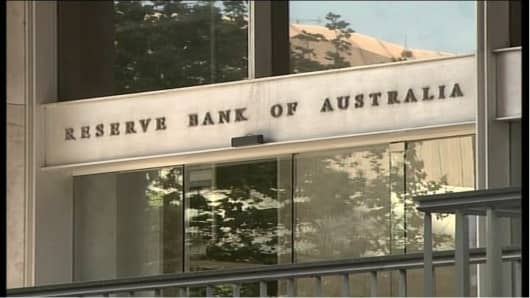Australia's central bank on Monday said the economy looked to be slowing enough to significantly reduce inflation over time, providing growing scope to ease interest rates from 12-year highs.
The Reserve Bank of Australia (RBA) gave little guidance on when it might cut rates but did warn that the deteriorating outlook for the world economy, made worse by the global credit squeeze, could be a serious risk to the economy at home.
"While inflation is likely to remain high in the short term, the Board judged at its August meeting that demand was slowing to an extent that could be expected to bring about a significant reduction in inflation over time," the central bank said in its 63-page Statement on Monetary Policy.
The RBA left interest rates unchanged at 7.25 percent at its monthly policy meeting last week but surprised many by suggesting there was growing room for what would be the first rate cut in seven years.
"On the assumption that the subdued demand conditions are likely to continue, scope to move to a less restrictive monetary policy stance in the period ahead is increasing," reiterated RBA Governor Glenn Stevens on Monday.
Financial markets are fully priced for a cut of at least 25 basis points at the RBA's next policy meeting in September.
The central bank said domestic spending looked to have slowed further since its last policy statement in May and this would likely be reflected in a weak reading for gross domestic product (GDP) in the second quarter.
As a result it trimmed 0.25 percent from its forecast for economic growth in 2008, seeing non-farm growth of just 1.5 percent. Estimates for growth out to 2010 were left unchanged.
"In addition to the effects of tighter financial conditions, other factors including a slowing in global growth, declining asset markets and higher fuel costs are acting to restrain domestic spending and activity," said the RBA.
Reflecting an unexpectedly high reading for inflation in the second quarter, the central bank revised up its forecasts for inflation in the short term but still predicted that core inflation would return to its 2 to 3 percent target by the second half of 2010.
The RBA saw consumer prices peaking around 5 percent in the fourth quarter of this year, while core inflation was seen reaching a 17-year high of 4.5 percent, driven in part by fuel and financial services costs.
The RBA said the consumer price figures for the second quarter had given some indication that inflation pressures were no longer rising. "But evidence of this was quite tentative," it cautioned.
If domestic demand did not slow as much as expected or the boost from a huge rise in the price of Australia's major resource exports proved stronger than expected, inflation expectations could become entrenched at unacceptably high levels.
Yet, the central bank also highlighted the more troubled outlook for global economies and the danger that any slowdown would lead to ever greater losses at banks and yet more tightening in world financial conditions.
"Any further deterioration in the outlook for global growth would represent a significant downside risk to the domestic activity profile, particularly if it led to a marked slowing in growth in China and India," said the RBA.
"In addition, the ongoing turmoil in capital markets could exacerbate the slowing in domestic growth by further reducing the availability of credit to households and businesses," warned the central bank.
Rising funding costs have led Australia's commercial banks to lift their mortgage rates by around 150 basis points in the past year, above the 100 basis-point rise in official rates.



